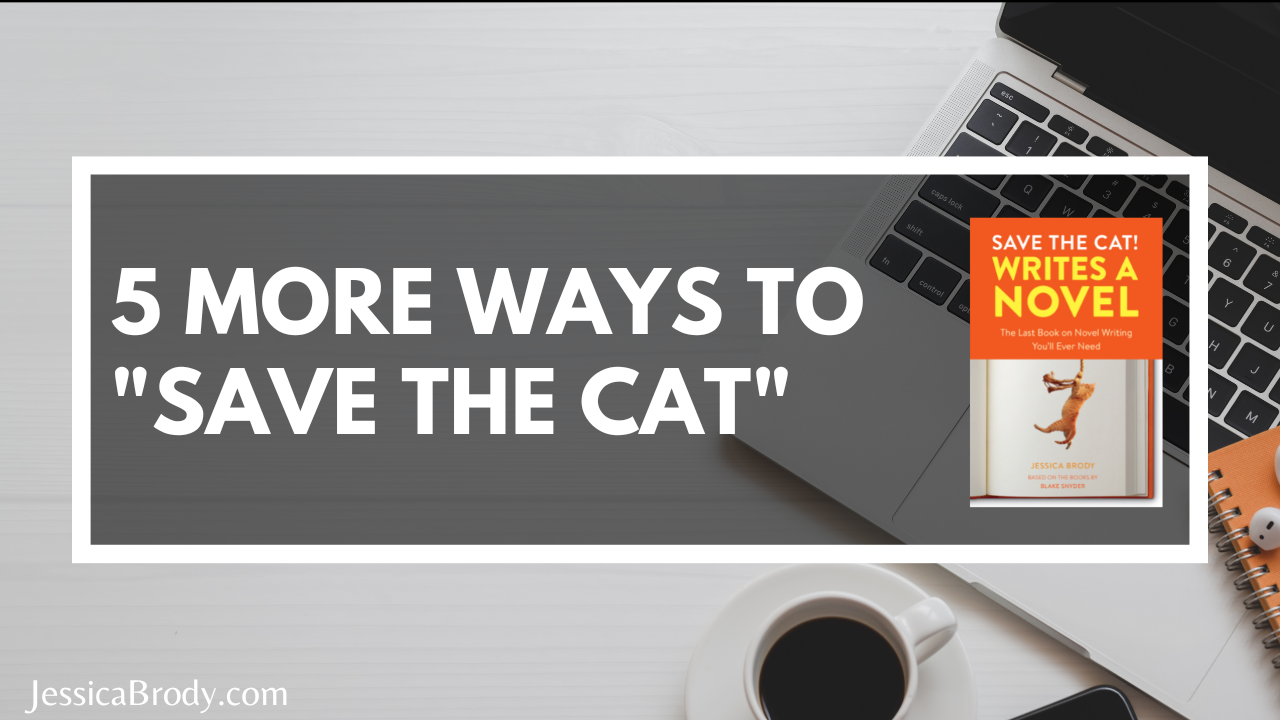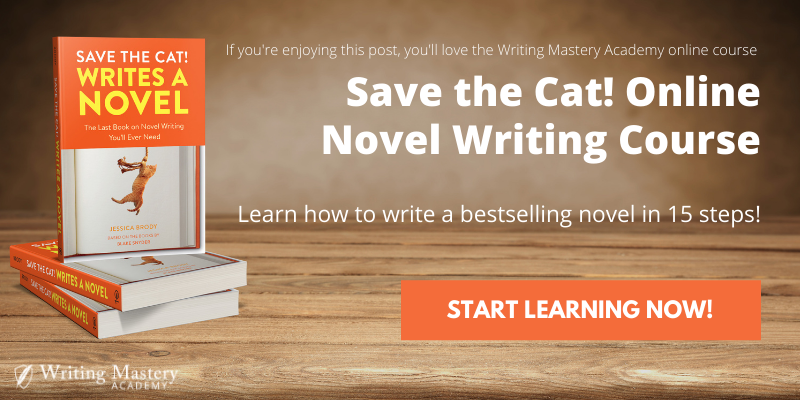5 More Ways to “Save the Cat”

“Why is it called Save the Cat!?”
A question I’ve been getting a lot since my novel-writing guide, Save the Cat! Writes a Novel, was first published back in 2018.
It’s often a confusing title because the term, “Save the Cat!” actually has very little to do with the core of the book, which is the 15-beat blueprint that writers can follow to craft a compelling story. (Click here for a quick crash course on the 15 beats)
The term “Save the Cat” refers not to any of these 15 beats but rather to a strategy that Blake Snyder included in his original screenwriting guide. It says, if you want to make your hero likeable or at least relatable, you should have that hero do something redeemable within the first 10% of your story, like save a cat.
But this tip often gets misconstrued and some writers think they actually have to add a scene to their story where a cat is literally saved (from a tree, shelter, or perilous situation).
Not true.
There are actually many ways to save a cat (i.e. have your hero do something redeemable or give them a quality that makes the reader like them, root for them, or want to keep reading to find out what happens to them).
So, for this blog post, I thought I’d break down 5 of my favorite ways to save a cat (none of which actually include any endangered felines.)
1) Have them help a stranger in need
This one is probably as close to saving a literal cat as you can get without actually saving a literal cat. If you want to get your reader on the side of your hero, a very fast way to do that is to show them helping someone in need, preferably someone they don’t know. This automatically gives the impression that this person has goodness in their heart and creates compassion in the mind of the reader.
My co-author and I used this technique in the first book our System Divine trilogy, Sky Without Stars, in which we show our hero, Chatine, (a con artist and thief) stealing a loaf of bread and then eventually (begrudgingly) giving it to a starving mother with a crying baby.
I recently saw this same tactic being used in the Hulu show The Old Man.
Minor Spoilers Ahead
At the start of episode 3, we meet a man at a bus stop who helps a woman with crutches onto the bus. Moments later, we find out this man in a professional hit man, hired to kill the main character. By the time we learn this, we’ve already felt some compassion for him, giving us all sorts of conflicting and intriguing emotions. The hit man is not the hero of the story but the effect is the same.
End of Spoilers
2) Give them a relative or close friend who relies on them
Also a popular choice, you can give your hero someone who relies heavily on them. For food, financial stability, security, medical supplies, or even emotional support. Once again, this shows compassion which easily transfers to your reader. So that whatever your hero does next (whether it be likeable or not), the reader already feels something for the hero and is invested in what happens to them.
A famous example of this strategy in action is from The Hunger Games by Suzanne Collins. Katniss’s sister Prim (and their mother) is highly dependent on Katniss not only to bring in extra food but to keep the family together.
Victoria Aveyard, author of Red Queen also used this tactic, introducing Mare as an important source of food and income for her struggling family.
And one of my favorite examples of this is from the classic Emma by Jane Austen. Emma is not known to be one of Jane’s most likable heroines. She’s a bit spoiled, self-involved, and “clueless” (hence the title of the modern-day adaptation starring Alicia Silverstone.) But her father would be absolutely lost without her. He’s an incredibly anxious man who relies heavily on Emma for support. And we soon learn that’s one of the reasons Emma has vowed to never marry. She can’t bear to leave her father alone. Aha! Now, we’re on her side.

3) Show a weakness or vulnerability
“Don’t judge someone until you’ve walked a mile in their shoes,” goes the old saying. Well, then, let us walk a mile in your hero’s shoes. Or rather, give us the “cliffnotes” version of that mile by just showing us a specific weakness or vulnerability.
This gets us instantly on your hero’s side by proving to us that they are, indeed, human. They are struggling with difficult emotions, tragic pasts, and vulnerabilities of their own.
In Dustin Thao’s You’ve Reached Sam, Julie is dealing with the aftermath of her boyfriend’s sudden death. She’s shut out all of his friends and family, refused to go to the funeral, and barely even talks about him anymore, which doesn’t sit well with some of the other characters who think she’s being cold. But we, the reader, are given a glimpse of her vulnerability. Her pain. We understand why she’s shutting everyone out. It’s just hurts too much.
I used this same tactic in my novel The Geography of Lost Things in which we first meet the hero, Ali, dealing with a recent break-up and doing everything she can to avoid her ex at school. But the focus of the Set Up beat is less on the break-up and more on the recent death of her father (a man she had a distant and strained relationship with). This serves to show the reader her vulnerability and maybe even shed some light on why the break-up with the ex happened in the first place.
4) Stack the conflict (or enemies!) against them
It’s hard to dislike someone when their world is falling apart and an evil ogre is trying to kill them. We can use conflict (both external and internal) to stack the odds against our heroes which in turn, stacks up the reader’s sympathy for what they’re going through.
In Sabaa Tahir’s An Ember in the Ashes, both heroes are faced with mounds of conflict right from the start. Laia’s brother is being hunted by the Empire for being a suspected rebel which leads to a raid on her house and the murder of her grandparents (all in the first few chapters!). Meanwhile Elias is trying to escape the Empire to which he’s pledged his loyalty and service as a soldier. And then we learn that his own mother is his commander and a pretty evil villain to boot. Instantly, we’re on both of their sides in part due to the sheer amount of conflict and enemies they’re dealing with.
I went with more emotional conflict in my novel, The Chaos of Standing Still, in which the hero, Ryn, is trying to survive the upcoming one-year anniversary of the death of her best friend. A death she still hasn’t properly grieved. As that fateful day looms closer, so does the emotional pain that she knows she will experience. Stacking up this emotional conflict right from the start was done quite purposefully, to try to bring the reader into Ryn’s world and her pain in an impactful and engaging way.
5) Make them really good at what they do
Admittedly, I think this one is the hardest to pull off but I absolutely love when it’s done well so I wanted to include it.
We, as humans, enjoy watching people crush it in their fields. We’re fascinated by geniuses, virtuosos, and wunderkinds (or wunderkid if you’re a Ted Lasso fan). When someone is really good at what they do, we can’t help but want to watch them (hence the reason I’m so obsessed with Simone Biles.). And we can use this same idea to get our readers behind our heroes.
The most obviously example of this, to me, is Sherlock Holmes, who is never really that likeable in any rendition of the character. In fact, his coldness and unlikability is one of his defining characteristics. And yet, that guy keeps fascinating us! Why? Because he’s brilliant and we like watching him in action.
Same goes for Beth Harmon, the hero of the Netflix limited series, The Queen’s Gambit. She’s not the kind of character you meet and instantly want to be BFFs with. But she’s kind of character you meet and instantly want to stick with, just to see her play another chess match.
It’s also, I believe, one of the reasons readers fall so head over heels in love with Kaz Brekker from Leigh Bardugo’s Six of Crows. Not because he’s saved any cats but because we love watching his brilliant mind work. We delight in seeing him always stay one move ahead of everyone else and discovering just how he’s going to get himself out of the next predicament (and the next, and the next…)
But like I said, this one can be difficult to pull off. When someone is so good at what they do, they run the risk of becoming even more unlikable, because they’re automatically less relatable. This strategy can easily backfire if you’re not careful. Which is why I recommend pairing this one with another method (either from this list or your own imagination) to make sure your hero is not all virtuosity and no vulnerability.
For example, Beth Harmon isn’t just a prodigy chess player. She’s also an orphan who’s been mistreated and soon develops a substance abuse problem. (Which serves as both conflict and vulnerability).
Kaz Brekker isn’t just a criminal mastermind. He’s also dealing with a tragic backstory, has a hidden weakness for Inej (whom he saved from the Menagerie) and is seeking vengeance on a bitter enemy.
In other words, readers will only be fascinated with brilliance for so long. Eventually they’re going to want to get a peek at the humanity that’s hiding beneath the surface,
So, those are 5 of my favorite ways to Save a Cat without actually having to endanger any fictional cats in the process. I should also note that these methods can be combined for double the impact.
In Sky Without Stars, we show Chatine giving her loaf of bread to a starving mother only moments before we introduce her horrible, abusive parents (layering in the conflict and the vulnerability).
And what about that short scene I referenced from The Old Man?
Minor spoilers ahead!
In only a few minutes we not only see the hit man helping a woman in crutches onto a bus, we also hear him on the phone with his grandmother, assuring her that he got the right type of pain medication from the pharmacy, which shows a relative relying on him.
End of spoilers
And of course, these 5 strategies aren’t the only ways you can get your reader to root for your hero. Feel free to use your creativity and come up with your own!
Filed under: Tips for Writers Writing Mastery Tagged with: character fiction writing LMAP novel writing save the cat save the cat beat sheet save the cat writes a novel STC Starter Kit (LMAP) Tips for Writers writing hacks writing mastery writing tips writing tools